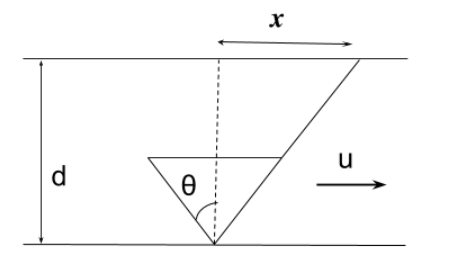
A man can swim with velocity $v$ relative to water. He has to cross the river of width $d$ flowing with the velocity $u(u > v)$ . The distance through which he carried downstream by the river is $x$ . Which of the following is correct?
A. If he crosses the river in minimum time, $x = \dfrac{{dv}}{v}$
B. $x$ cannot be less than $\dfrac{{du}}{v}$
C. For $x$ to be minimum he has to swim in the direction making an angle of $\dfrac{\pi }{2} + {\sin ^{ - 1}}\left( {\dfrac{v}{u}} \right)$ with the direction of flow of water.
D. $x$ will be max if he swims in the direction of making an angle of $\dfrac{\pi }{2} + {\sin ^{ - 1}}\left( {\dfrac{v}{u}} \right)$ with the direction of flow of water.
Answer
220.2k+ views
Hint: - We will simply use $speed = \dfrac{{dis\tan ce}}{{time}}$ along with some geometry. In order to find the maximum and minimum of the particular quantity we will put slope equal to zero.
Complete step by step answer:

Given: Velocity of man relative to water $ = v$
Width of river $ = d$
Velocity of river $ = u$
Now, time required for crossing the river is given by
$\Rightarrow$ $t = \dfrac{d}{{{v_{parallel}}}}$
From figure, ${v_{parallel}} = v\cos \theta $ and ${v_{perpendicular}} = v\sin \theta $
$\therefore t = \dfrac{d}{{v\cos \theta }} \cdots \left( 1 \right)$
For the time to be minimum, $\theta $ should be zero
$\Rightarrow$ $t = \dfrac{d}{{v\cos 0}} = \dfrac{d}{v}$
Now, $x = $ horizontal velocity $ \times $ time
$\Rightarrow$ $x = \left( {u - v\sin \theta } \right) \times \dfrac{d}{{\cos \theta }}$
For minimum time,
$
x = \left( {u - v\sin 0} \right)\dfrac{d}{v} \\
x = \dfrac{{du}}{v} \\
$
From above,
\[
x = (u - v\sin \theta ) \times \dfrac{d}{{v\cos \theta }} \\
x = \dfrac{{ud\sec \theta }}{v} - d\tan \theta \\
\]
For $x$ to be minimum,
$\dfrac{{dx}}{{d\theta }} = 0$
That is,
$
\dfrac{{d\left[ {u\dfrac{d}{v}\sec \theta - d\tan \theta } \right]}}{{d\theta }} = 0 \\
\Rightarrow \dfrac{{ud}}{v} \times \sec \theta \tan \theta - d{\sec ^2}\theta = 0 \\
\Rightarrow \dfrac{u}{v}\tan \theta - \sec \theta = 0 \\
\dfrac{{u\sin \theta }}{{v\cos \theta }} = \dfrac{1}{{\cos \theta }} \\
\sin \theta = \dfrac{v}{u} \\
\theta = {\sin ^{ - 1}}\left( {\dfrac{v}{u}} \right) \\
$
The swimmer has to swim in the direction making an angle of $\dfrac{\pi }{2} + {\sin ^{ - 1}}\left( {\dfrac{v}{u}} \right)$ with the direction of flow of water.
Hence, option (A) and (C) are correct.
Note: - Since, in the question, $(u > v)$ hence, we have to add $\dfrac{\pi }{2}$ . If $v > u$ then, $\dfrac{\pi }{2}$ will be subtracted. Hence, for $x$ to be minimum, the swimmer has to swim in a particular direction with the direction of flow of water.
Complete step by step answer:

Given: Velocity of man relative to water $ = v$
Width of river $ = d$
Velocity of river $ = u$
Now, time required for crossing the river is given by
$\Rightarrow$ $t = \dfrac{d}{{{v_{parallel}}}}$
From figure, ${v_{parallel}} = v\cos \theta $ and ${v_{perpendicular}} = v\sin \theta $
$\therefore t = \dfrac{d}{{v\cos \theta }} \cdots \left( 1 \right)$
For the time to be minimum, $\theta $ should be zero
$\Rightarrow$ $t = \dfrac{d}{{v\cos 0}} = \dfrac{d}{v}$
Now, $x = $ horizontal velocity $ \times $ time
$\Rightarrow$ $x = \left( {u - v\sin \theta } \right) \times \dfrac{d}{{\cos \theta }}$
For minimum time,
$
x = \left( {u - v\sin 0} \right)\dfrac{d}{v} \\
x = \dfrac{{du}}{v} \\
$
From above,
\[
x = (u - v\sin \theta ) \times \dfrac{d}{{v\cos \theta }} \\
x = \dfrac{{ud\sec \theta }}{v} - d\tan \theta \\
\]
For $x$ to be minimum,
$\dfrac{{dx}}{{d\theta }} = 0$
That is,
$
\dfrac{{d\left[ {u\dfrac{d}{v}\sec \theta - d\tan \theta } \right]}}{{d\theta }} = 0 \\
\Rightarrow \dfrac{{ud}}{v} \times \sec \theta \tan \theta - d{\sec ^2}\theta = 0 \\
\Rightarrow \dfrac{u}{v}\tan \theta - \sec \theta = 0 \\
\dfrac{{u\sin \theta }}{{v\cos \theta }} = \dfrac{1}{{\cos \theta }} \\
\sin \theta = \dfrac{v}{u} \\
\theta = {\sin ^{ - 1}}\left( {\dfrac{v}{u}} \right) \\
$
The swimmer has to swim in the direction making an angle of $\dfrac{\pi }{2} + {\sin ^{ - 1}}\left( {\dfrac{v}{u}} \right)$ with the direction of flow of water.
Hence, option (A) and (C) are correct.
Note: - Since, in the question, $(u > v)$ hence, we have to add $\dfrac{\pi }{2}$ . If $v > u$ then, $\dfrac{\pi }{2}$ will be subtracted. Hence, for $x$ to be minimum, the swimmer has to swim in a particular direction with the direction of flow of water.
Recently Updated Pages
Electricity and Magnetism Explained: Key Concepts & Applications

JEE Energetics Important Concepts and Tips for Exam Preparation

JEE Isolation, Preparation and Properties of Non-metals Important Concepts and Tips for Exam Preparation

JEE Main 2021 July 25 Shift 1 Question Paper with Answer Key

JEE Main 2021 July 22 Shift 2 Question Paper with Answer Key

States of Matter Chapter For JEE Main Chemistry

Trending doubts
JEE Main 2026: Application Form Open, Exam Dates, Syllabus, Eligibility & Question Papers

Understanding Uniform Acceleration in Physics

Derivation of Equation of Trajectory Explained for Students

Hybridisation in Chemistry – Concept, Types & Applications

Understanding the Angle of Deviation in a Prism

How to Convert a Galvanometer into an Ammeter or Voltmeter

Other Pages
Thermodynamics Class 11 Physics Chapter 11 CBSE Notes - 2025-26

JEE Advanced Marks vs Ranks 2025: Understanding Category-wise Qualifying Marks and Previous Year Cut-offs

Units And Measurements Class 11 Physics Chapter 1 CBSE Notes - 2025-26

NCERT Solutions For Class 11 Physics Chapter 8 Mechanical Properties Of Solids

Motion in a Straight Line Class 11 Physics Chapter 2 CBSE Notes - 2025-26

NCERT Solutions for Class 11 Physics Chapter 7 Gravitation 2025-26




